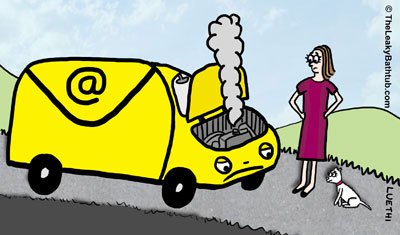
If you own a car, chances are that at some stage it’s broken down. Whether it’s a flat tyre or something more serious, most of us have been there.
But just because your car’s broken down, does that mean that you decide that cars in general are broken? And you vow to never use a car again?
Unlikely!
You’re far more likely to get your mechanic to fix the car. (Or if all else fails, you might get a new car.)
Yet when email marketing breaks down, people are quick to say that “email marketing is dead”.
Is email marketing dead?
No, email marketing isn’t dead: it’s simply evolved over time. Just like there’s more traffic on the roads; and we no longer use crank handles to start a car engine, technology changes and evolves. And that’s what’s happened to email marketing.
Yes, you might be finding it harder to grow your opt-in list. Yes, your open rates might be down. And yes, your unsubscribe rates might be up. But that doesn’t mean that all email marketing is broken; it just means it’s time you tweaked it. Just like a car needs fixing and servicing, so does email marketing.
Still not convinced that email marketing works?
If you need convincing that email marketing works, here’s how my own email marketing is looking at the time of writing. In the past year my email opt-in list has grown by 36%; open rates have increased by 34%; and my click-through rate has increased by 414% (yes, you read that correctly). And in terms of earning dollars, my email list provides me with a regular flow of repeat consulting and copywriting work, referral business and eBook sales.
How did I achieve these results? By following the tips I’m about to share with you. Nothing more and nothing less!
I should also mention that colleagues of mine who are black belts in email marketing are getting even better results than I am: they have larger lists, and through this they are able to make sales on a daily basis. What they’re achieving is inspiring, and shows us what’s possible – and they’re getting these results without spending very much money on their marketing.
Email marketing is possibly the most cost-effective customer retention method
Customer retention is a vital marketing strategy; and email marketing lets you communicate with your Customers, Members, Advocates and Raving Fans cost-effectively and time-efficiently.
Can you think of any other communication method that lets you communicate directly with all your fans for just a few cents? At this point you might be thinking ‘social media’ – but this doesn’t let you communicate directly: there’s a very good chance your updates may not be seen. With email, they’ll see your message in your InBox… and even if they don’t open your email, at least you’re still front of mind.
So yes, email marketing still reigns. If you’re not getting the results that you used to get, it indicates that it’s time to give it a re-tune and tweak.
Here’s your 11-point email marketing recovery plan:
1. Review your costs
Are you finding email marketing expensive? If so, you need to look at the costs. In particular:
- Email newsletter software: if you find your current system expensive, shop around. Many of my clients are raving about MailChimp‘s free plan; it’s very good.
- Labour costs: many business owners dislike writing newsletter content and setting it up. You have two main choices: either learn to do it yourself; or outsource it. One thing you don’t want to skimp on though is the content: we’ll come onto that later. Whoever does this needs to know what they’re doing, as it’s the content that will make or break your email marketing. So if you decide to write your own content, make sure you brush up on your copywriting skills.
2. Attract new subscribers continually
Just like cars need fuel, subscribers are the lifeblood of your email marketing and you need to work at continually attracting new (quality) subscribers. Make it easy for people to sign up to your list, for example by having a sign-up form on your website. And be sure to tell subscribers exactly what they’re signing up for: reassure them that their personal data will be kept private, and let them know how often you’ll contact them. Setting expectations upfront is a good thing.
These days it’s certainly become harder to entice new subscribers, and for this reason it can be a good idea to offer a high quality enticement. This could be a free eBook, Report or White Paper that subscribers receive in return for signing up. This gift should be geared to a common need your subscribers have; be of good quality; and not overly long (because you actually want them to read it!).
If you use social media, make sure that you’re regularly enticing your followers to sign up to your email list. It’s far more important that you grow your email list than your Facebook fans or Twitter followers.
Why? You want to own your customer data; you should not rely on a third party (such as Facebook). You have no control over Facebook. Imagine if the site closed down overnight for some reason: all your fans would be gone along with it. That’s why it’s so important that you focus on growing your email marketing list first and foremost: you shouldn’t build your business on someone else’s land, so to speak.
3. Email subject lines must be amazing!
Subscribers will choose whether to open your email or not based on your subject line. And to write an enticing subject line means you need to have good headline writing skills. Click here to see what makes a good headline.
If your headline isn’t strong enough, the rest of the content is immaterial. So writing a good headline is essential.
Many email newsletter systems let you send “split test broadcasts” (or “A/B testing”), which will let you test and measure different headlines to see which gets the best open rate and the best click-through rate. Give that a try, so you can see what your subscribers respond to.
Hint: if you did this a while ago (say a year or two ago), do it again. The world has changed since then, and so have people’s needs and motivations.
4. Develop a strategy for your email marketing content
This is where many people trip up, as they’re not clear on what they should be doing. There are 3 different kinds of email marketing, and you need to be clear on what they are, and the difference between them.
- Email newsletters: Most of the content (around 80%) should be focused on adding value to your reader, e.g. an article that they will find interesting or beneficial in some way. A maximum of 20% of the email should be sales-based. (And be sure to feature the value-added article first, and only then the offer.)
- Sales emails: Pure sales emails are an important tool in your email marketing toolkit, but use them sparingly as readers tire very quickly of being bombarded by sales messages.
- Autoresponders: These are a series of automated emails that arrive in short, sharp succession after sign-up. After all, you are most at front-of-mind when people have just joined your list. Autoresponders are generally short; have a personal tone; and are about adding value.
All of these require a different approach. And the content for each of these will be very different… and ideally you will be engaging all 3 techniques. After all, if you were to drive your car just in one gear, your journey would be slow and frustrating, so you use all the gears available to you. Same with your email marketing: to get it cranking, you need to use all the techniques at your disposal.
You will need to suss out a way to mix the different email marketing methods: the email newsletters, sales emails and autoresponders should be working harmoniously together.
If that sounds hard, I’m afraid you should grit your teeth and do it, it is OK! It is worse to keep doing what you’re doing (and not get results) or to omit email marketing from your marketing campaigns altogether. After all, a mechanic often has to do diagnostics to find out what’s wrong with a car, so this is you doing the same thing for your business.
5. Create the content that fits your strategy
Now that you have a strategy to work to for each email, the goal of your writing work becomes a lot clearer. And be sure to treat your list like the VIPs that they are and give them quality information.
Quality content means including graphics and captions, as well as good writing. And be sure to provide links to your website where your readers can find more information.
Hint #1: Less is more. Rather than cram in lots of content and lots of articles, let one high-quality article be the feature of your email marketing. One clear theme will be more memorable than a multitude of messages.
Hint #2: This is the bit where most people get stuck; they’re not sure what their readers find most interesting/beneficial, and what they don’t like. There’s only one sure fire way to find out for certain. And that is covered in the next step:
6. Ask your readers for feedback
Email marketing can be a weird feeling: you spend hours toiling over it; hit send; and often you get zero feedback. If it weren’t for your statistics, you’d be wondering if the emails ever got sent!
If that’s how things are feeling to you, you need to get some feedback from your readers. And not just any old readers, but your biggest advocates, i.e. the kind of A-Grade customers you’d like to have more of.
If you know them well enough, ask them personally: be sure to ask open-ended questions to get their feedback, i.e. questions beginning with: how, why, what, when, etc.
Another option is to do a quick online survey to see what readers think. Just make sure you keep it simple (just 3 quick questions), and offer a prize draw incentive for those who take part. After all, their feedback is vital for your business, and as no-one really enjoys filling in forms, it’s wise to acknowledge that they’re sticking their neck out helping you by offering a reward.
There are free online survey tools you can use: SurveyMonkey is a popular option, and there are plenty of other services too. (Just do a web search for “free online survey”.)
7. Are there any treats in your email newsletters?
… or in other words, do you treat your readers like dogs?
Dogs love treats. And once you start giving them treats, they’ll want more and more. In fact, they’ll start expecting the treats – and boy will you get big, sad looks if you come up empty-handed!
Same thing in your email newsletters. Is there a little extra something you can easily slot into your emails? This Copyblogger article will give you some ideas and tips on creating this kind of email content.
By doing this in each newsletter issue (and yes, just newsletters, not sales emails or Autoresponders), your readers will start looking out for them.
8. Ensure your template is appropriate
All this wonderful content you’ve created needs to go into a branded email newsletter template. This should look smart and professional. But most importantly of all, your template needs to be smart phone compatible. Why? An increasing number of people read emails on their cell phones, so if your template is a few years old or not specially designed for cell phones, people might be unsubscribing and deleting your emails simply because they can’t read it.
Test and check your template; if it’s not cell phone compatible, you need a new template urgently.
9. Write a sequel (or two)
Have you noticed how many popular books (and movies) have sequels? For example, there are seven books in the Harry Potter series. ‘The Hunger Games’ is a trilogy. So is ‘Fifty Shades of Grey’. Many authors and publishing houses have realised that readers want more and more and more. Each book leaves you wanting to read the next book.
Use the same approach in your email newsletters: rather than making each one a stand-alone blockbuster, write a mini-series. And then tell the reader that that’s what you’re doing, because then they’ll look out for the next email newsletter, as they’re already anticipating it. This does wonders for your open rates!
I’ve been using this approach myself, (a) by sometimes writing a mini-series in my email newsletters, and (b) including a short blurb with a teaser in a section entitled In the next issue. My open rates have never been looking healthier. Sure, it means you have to plan your content in advance (read: being organised and planning ahead), but it is very well worth it.
10. Re-evaluate the frequency
Are you sending your emails too often – or not often enough? Generally speaking, the more frequently you can send email newsletters (with quality content that adds value), the better.
If your email newsletters have broken down, rather than send the newsletters less often, you should tend to the items on this recovery plan and then send your newsletters more often!
Why? Life is incredibly fast paced and is speeding up. You need to keep up, rather than slow down, if you want your business to thrive. You can slow down when you’re retired. 😉
11. Be consistent
The biggest email killer by far is not being consistent in your frequency. Getting the newsletter out on time, every time is essential… no excuses. If you do not do this, believe me, it gets noticed. Your customers and prospects will start questioning your professionalism: they’ll wonder if you’re so slack in all aspects of your business. Whilst that sounds harsh, remember that people will judge you based on what they see (or don’t see), and will make assumptions about your business based on that.
So how do you get your newsletter out on time each time? My tips are to:
- Draw up a production schedule for the next year. Identify (a) the send-out dates and (b) the materials deadline dates. Give yourself some time to put the newsletter together.
- Write these dates and deadlines in your diary… and stick to them!
- Use quiet times to your advantage and pre-prepare content in advance. Email newsletter systems will let you queue things waaaay in advance. So if you know you’re going to be on holiday, get that newsletter set up a week or two (or more) before you leave.
Summary
Email marketing continues to be the most cost-effective way to build relationships with your customers and to generate sales. If your email marketing isn’t delivering results, it’s not the medium that’s at fault, rather the implementation of it. So get under the hood and tinker and fine-tune till it’s humming again! (It may even perform better than it did before it broke down!)




